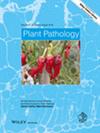植物病原体新靶点发现的比较组学分析:以稻瘟病菌为例
IF 2.4
3区 农林科学
Q1 AGRONOMY
引用次数: 0
摘要
化学农药应用的主要问题是其对非目标生物的潜在不利影响。对于真菌病原体,由于这些病原体和人类之间共享的途径的相似性,寻找特定靶点变得复杂。我们提出了一个综合的策略,整合比较组学和生物信息学,以确定对稻瘟病的真菌病原体稻瘟病有效的杀菌剂的精确目标。我们的方法涉及减法代谢途径,同源筛选和目标优先级。通过减法代谢分析,我们确定了三个独特的M. oryzae途径,不同于人类和水稻。非冗余蛋白序列随后对人类和水稻以及来自不同生物的其他数据库进行BLASTP筛选。目标亚细胞定位预测使用八种工具,包括人工智能和深度学习方法。对生物过程进行了全面的研究,包括基因表达、蛋白-蛋白相互作用、网络富集、广谱活性和理化分析。谷氨酸5激酶成为靶向杀菌剂开发的主要候选物,在精确导向的解决方案中有希望取得进展。本文章由计算机程序翻译,如有差异,请以英文原文为准。

Comparative omics analysis for novel target discovery in plant pathogens: A case study for Magnaporthe oryzae
The central concern surrounding chemical pesticide application is its potential adverse effects on non-target organisms. For fungal pathogens, the search for specific targets has been complicated by the similarities in pathways shared between these pathogens and humans. We present a comprehensive strategy, integrating comparative omics and bioinformatics, to pinpoint precise targets for fungicides effective against the fungal pathogen Magnaporthe oryzae, responsible for rice blast disease. Our approach involves subtractive metabolic pathways, homology screening and target prioritization. Through subtractive metabolic analysis, we identified three unique M. oryzae pathways, distinct from human and rice. Nonredundant protein sequences were subsequently subjected to BLASTP screening against human and rice, as well as other databases from diverse organisms. Target subcellular localization was predicted using eight tools, including artificial intelligence and a deep-learning method. A comprehensive examination of biological processes was conducted, including gene expression, protein–protein interactions, network enrichment, broad-spectrum activity and physicochemical analysis. Glutamate 5-kinase emerged as the prime candidate for targeted fungicide development, promising progress in precision-oriented solutions.
求助全文
通过发布文献求助,成功后即可免费获取论文全文。
去求助
来源期刊

Plant Pathology
生物-农艺学
CiteScore
5.60
自引率
7.40%
发文量
147
审稿时长
3 months
期刊介绍:
This international journal, owned and edited by the British Society for Plant Pathology, covers all aspects of plant pathology and reaches subscribers in 80 countries. Top quality original research papers and critical reviews from around the world cover: diseases of temperate and tropical plants caused by fungi, bacteria, viruses, phytoplasmas and nematodes; physiological, biochemical, molecular, ecological, genetic and economic aspects of plant pathology; disease epidemiology and modelling; disease appraisal and crop loss assessment; and plant disease control and disease-related crop management.
 求助内容:
求助内容: 应助结果提醒方式:
应助结果提醒方式:


